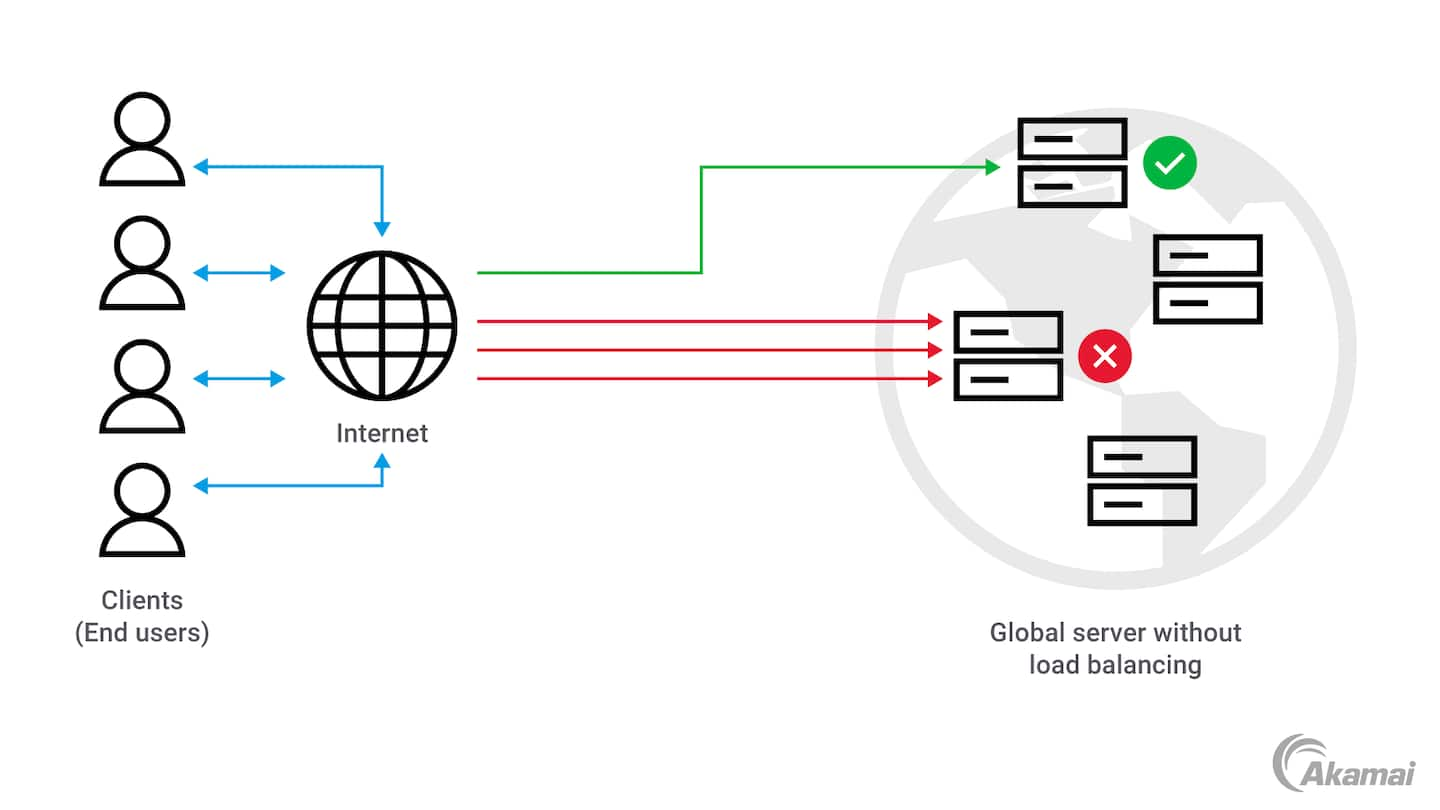In many cases, yes. Cloud or software load balancers often present a cost-effective solution, especially for businesses operating in virtualized environments. However, the choice depends on specific needs and scalability requirements.
Global server load balancing (GSLB) is the practice of distributing web and application traffic across multiple servers in different locations to improve network performance, increase reliability, and achieve high availability. By directing traffic to the least congested servers or to the servers closest to users, GSLB enables faster and more reliable response times for better user experiences.
There are many commercial solutions available that can facilitate global server load balancing. The diagrams below illustrate how Akamai’s Global Traffic Management solution distributes workloads to improve network performance.
Global load balancers determine the optimal server by applying rules that consider factors such as network latency, geographic closeness, server status, current network conditions, server capacity, and additional parameters.
How does global server load balancing work?
Global server load balancing relies on a network of servers distributed around the world to direct traffic and balance workloads. When a user requests access to a website or content from a server, GSLB servers determine which server or data center should serve the content or provide a service based on intelligent load balancing algorithms. Global load balancers calculate the best server based on rules that take into account network latency, geographic proximity, server availability, network conditions, server load, and other criteria. Once the most appropriate server is chosen, global load balancers steer the user’s request to that destination by returning the IP address of the selected server in the DNS response.
How does global server load balancing improve performance?
GSLB continuously performs health checks for the network and monitors the availability of servers on it. GSLB can also perform failover and failback — when a server experiences performance issues or fails, GSLB directs traffic to other servers to ensure high fault tolerance and greater availability, and returns the traffic once the failed location is reliably healthy.
What are the methods of global server load balancing?
Global server load balancing solutions use a variety of traffic management methods to distribute traffic across servers around the world. Some GSLB solutions use multiple load balancing methods to provide a more robust response.
- DNS load balancing often relies on the domain name system (DNS) to intelligently distribute traffic across multiple servers or data centers. When a user initiates a DNS server request, the GSLB system responds to the DNS query with an IP address for a server based on a load balancing strategy. Strategies include round-robin, where successive requests are sent to different servers, and smart techniques that analyze a variety of factors to determine which server can best handle a request.
- IP anycast is a routing service that enables multiple servers to share a single IP address. When a request to the shared IP address is received, GSLB routes traffic to the nearest server to provide automatic load balancing.
- BGP-based load balancing uses the Border Gateway Protocol (BGP) routing protocol to route traffic based on network availability or server location.
- Content Delivery Networks (CDNs) use GSLB techniques to direct users to the optimal server within a CDN, a distributed network of servers that cache and deliver content to end users from the closest server.
- Global traffic managers are often hardware or software appliances that monitor the health and performance of servers or data centers and distribute traffic based on predefined load balancing algorithms.
- Geographic load balancing directs traffic to the IP address that’s closest to the user to reduce latency and improve response times.
What are GSLB’s greatest benefits?
The benefits of GSLB solutions include:
- Improved performance. By enabling content to be delivered from servers closer to the user, GSLB helps to minimize network latency and reduce the likelihood of delays.
- Greater reliability and availability. Load balancers can direct traffic around servers or networks that are experiencing outages or congestion to ensure that traffic reaches its destination.
- Compliance. Global server load balancers can be configured to comply with specific regulations and security requirements in highly regulated industries like healthcare, defense, and communications.
- Disaster recovery. When a disaster affects the availability of one data center or network, GSLB can redirect requests to other servers that are still operating.
- Localized content. Organizations can use GSLB to steer user traffic to specific local data centers, enabling them to provide localized content that relates to the geographic location of the users or to meet country-specific regulatory or security requirements.
Frequently Asked Questions (FAQ)
Server load balancing distributes incoming traffic, preventing any single server from being overwhelmed. This results in improved response times, enhanced user experiences, and optimal website performance.
No, server load balancing is beneficial for businesses of all sizes. It ensures that resources are used efficiently, preventing server overload and downtime, irrespective of the scale of operations.
Regular reviews are essential to ensure continued optimal performance. Factors such as traffic patterns, application updates, and evolving business needs necessitate periodic assessments and adjustments.
Why customers choose Akamai
Akamai is the cybersecurity and cloud computing company that powers and protects business online. Our market-leading security solutions, superior threat intelligence, and global operations team provide defense in depth to safeguard enterprise data and applications everywhere. Akamai’s full-stack cloud computing solutions deliver performance and affordability on the world’s most distributed platform. Global enterprises trust Akamai to provide the industry-leading reliability, scale, and expertise they need to grow their business with confidence.



